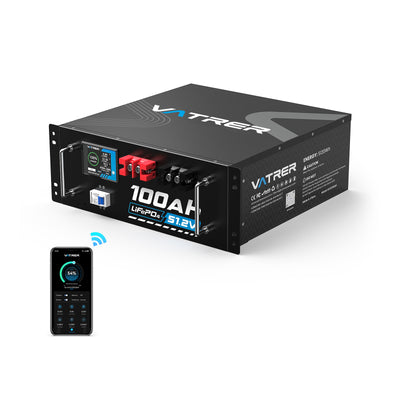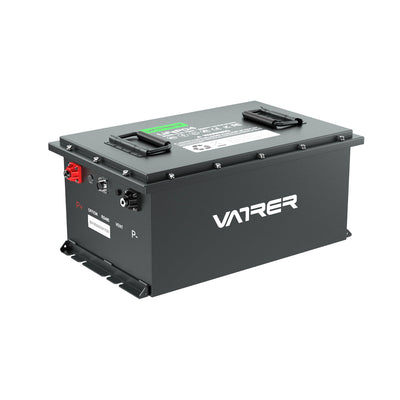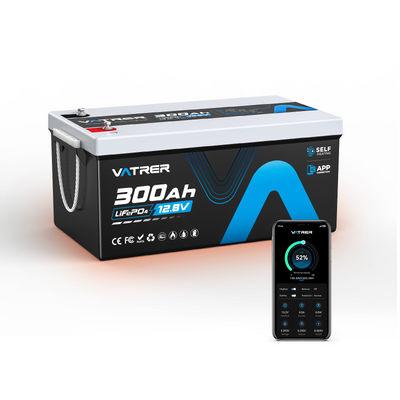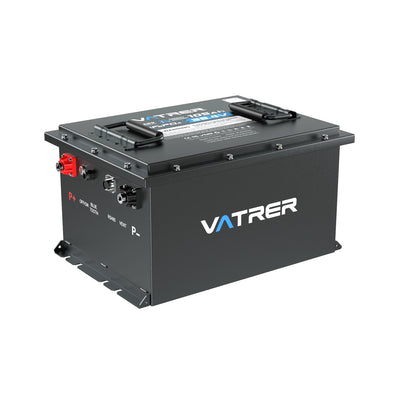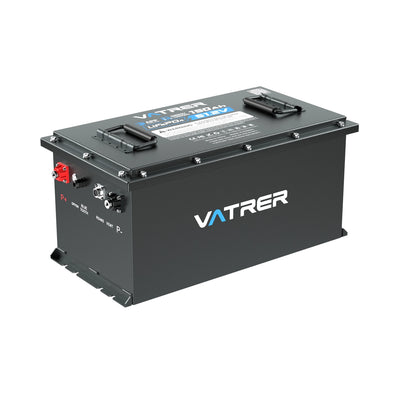
How Long Do Deep Cycle Batteries Last?
Fed up with swapping out batteries in your solar system or RV every few years? If you’re wondering how long a deep cycle battery really lasts, it helps to know that these batteries are designed to deliver steady power for gear like boats, off-grid cabins, and marine equipment, but their service life depends heavily on battery chemistry, how they’re used, and how well they’re maintained.
In the sections below, we’ll walk through the main factors that influence lifespan and share practical advice to help you select, use, and look after a deep cycle battery properly. With a bit of planning, you can avoid unexpected failures and enjoy dependable power over the long term.
What Is a Deep Cycle Battery and Why It Matters for Longevity?
A deep cycle battery is built to deliver a steady flow of energy over extended periods and to tolerate being discharged and recharged many times with limited loss of capacity. This is different from starter batteries, which are meant to provide a brief, high-current burst to crank an engine. Because of this design, deep cycle batteries are better suited for applications that draw power continuously, such as running loads in an RV or storing energy from solar panels.
You’ll commonly see them in solar energy storage banks, backup power (UPS) systems, boats with trolling motors, golf carts, electric transport, and off-grid or remote homes. Main categories include flooded lead-acid batteries, gel batteries, AGM batteries, and newer lithium-ion technologies such as LiFePO4.
Lithium models generally offer higher energy density and improved efficiency, so they can be discharged more deeply without damage. This usually translates into a longer overall lifespan compared with traditional lead-acid batteries, which need more careful operation to avoid early failure.
Still not quite clear on how deep cycle batteries differ from standard ones? Have a look here: What are deep cycle batteries?

Exploring How Long Deep Cycle Batteries Last by Type
Most deep-cycle batteries will last somewhere between 3 and 10 years or more, but a more accurate way to look at life is in charge/discharge cycles. One cycle is typically defined as using the battery from full charge down to a certain level and then recharging it. The depth of discharge (DoD) is critical here: discharging only to about 50% can roughly double the number of usable cycles compared with pushing the battery to 90% DoD, because shallower cycling puts less strain on the internal components.
Conventional lead-acid deep cycle batteries usually deliver around 300 to 500 cycles, whereas lithium batteries perform far better. For example, in an RV where you cycle the battery daily to power lighting and onboard equipment, a lithium RV battery can hold voltage more consistently and may last three to five times longer than a comparable lead-acid unit in everyday conditions.
To make comparison easier, the table below outlines how common deep cycle battery types differ in performance characteristics:
| Type of Battery | Typical Lifespan (Years) | Charge-Discharge Cycles | Depth of Discharge (Recommended) | Maintenance Level |
|---|---|---|---|---|
| Flooded Lead-Acid | 3-5 | 300-500 | 50% | High |
| Gel | 4-7 | 500-1,000 | 50-70% | Medium |
| AGM | 4-7 | 500-1,000 | 50-80% | Low |
| Lithium (LiFePO4) | 8-10 | 2,000-5,000 | 80-100% | Very Low |
Because lithium deep-cycle batteries use lithium iron phosphate chemistry, they tend to be more stable and safer in operation, and their service life is noticeably longer than most other deep cycle options.
If you’re after a dependable lithium solution for camping in your RV, the Vatrer 12V deep-cycle battery is a strong candidate. For a deeper dive into RV battery choices, see: What's the Best Deep-Cycle Battery for RVs?
Key Factors That Affect the Lifespan of a Deep Cycle Battery
Average lifespan figures for each battery type are only part of the story. How you use and where you operate the battery can significantly change the outcome. Below are the main elements that influence how long a deep-cycle battery will actually last. Recognizing these early gives you a chance to adjust your habits and avoid premature failure.
Maintenance Practices: Routine care is one of the most important contributors to battery life. With flooded lead-acid batteries, you should inspect electrolyte levels regularly so the plates never end up exposed, which can cause permanent damage. It’s also important to clean terminals so corrosion does not restrict current flow. AGM and gel batteries require much less attention, but occasional visual checks are still useful. Lithium batteries simplify things further by integrating a Battery Management System (BMS) that automatically guards against typical problems, reducing user error and helping extend life.
Tip: Add a monthly reminder to your calendar to perform quick checks before minor issues turn into major ones.
Temperature Conditions: Both heat and cold influence the chemistry inside the battery. Every 10°C rise above about 25°C (77°F) can shorten lifespan by roughly 20–50% by accelerating ageing reactions. Colder conditions mainly reduce available capacity temporarily, without necessarily causing the same level of lasting harm. For most setups, aiming to operate and store batteries between 50–77°F (10–24°C) yields better results. In harsher climates, insulated boxes or climate-controlled compartments can help keep batteries within a healthier range.
Operating Environment: Beyond temperature alone, the surrounding environment also plays a role. Good airflow is essential, especially for lead-acid batteries, to safely disperse hydrogen and oxygen generated during charging. This minimizes the risk of gas build-up and helps keep components cooler. Poor ventilation may lead to overheating or corrosion, so install batteries in dry, well-ventilated spaces away from standing moisture or heavy dust.
Usage Patterns: The way you draw power from the battery is another major factor. High power loads, frequent deep discharges, or rapid cycling increase stress and speed up wear. In lead-acid batteries, this often shows up as sulphation on the plates, which increases internal resistance and permanently reduces capacity. Lithium batteries handle these conditions better because the BMS manages current and voltage limits to keep stresses within a safer range.
Tips: Use a meter or battery monitor to keep an eye on your load and try to plan for moderate discharge levels so you balance daily energy use with long-term life.
Battery Quality and Design: Construction quality has a direct impact on durability. Higher-grade batteries use better materials and manufacturing processes that hold up more effectively under cycling, vibration, and thermal stress. Lower-cost products may reach end-of-life earlier even if they are used in similar conditions. When choosing a battery, look for established brands that offer warranties based on cycle life, such as Vatrer Battery, as this usually reflects a stronger build designed for demanding applications.
Thinking about upgrading or replacing your current bank? Vatrer deep-cycle batteries include built-in BMS protection and low-temperature features. They’re available in multiple capacities and configurations, including self-heating designs. Whether your priority is RV travel, an electric golf cart, or solar storage at the cottage, there’s a Vatrer battery built to fit your setup.
Practical Tips on How to Extend the Lifespan of Deep Cycle Batteries
Once you understand what affects the life of deep-cycle batteries, you can apply targeted, proactive measures—similar to preventative maintenance on any critical power system. Below are straightforward steps you can start using right away:
Proper Charging Techniques: Always pair your battery with a charger designed for that specific chemistry so you don’t risk chronic overcharging or undercharging, both of which slowly damage cells.
For lead-acid batteries, running an equalization charge every 1–3 months helps even out cell voltages and reduce sulphation on the plates. This involves a controlled overcharge using the charger’s equalize setting according to the manufacturer’s instructions.
Lithium batteries charge more quickly and efficiently—often in about half the time of lead-acid—but they should not be charged with a standard lead-acid charger, as the voltage profile is different. Using the wrong charger can lead to incomplete charging or, in the worst case, damage.
Tip: Consider a Vatrer smart charger with automatic shut-off and appropriate profiles for safer, more convenient charging.
Routine Maintenance and Inspections: Regular inspection helps catch problems before they escalate. Check battery terminals monthly for corrosion and, if needed, clean them with a baking soda and water solution plus a small wire brush so connections remain secure.
For flooded lead-acid units, verify electrolyte levels and top up with distilled water to keep plates fully covered. It’s best to do this after charging so the electrolyte level is stable and you avoid overflow.
AGM and gel batteries are sealed and generally low-maintenance, while lithium batteries demand very little user intervention thanks to integrated BMS protection.
Tips: Keep a simple maintenance log to track when inspections and top-ups were done, which makes it easier to spot patterns or recurring issues.
Optimal Storage Practices: When a battery will not be used for a while, proper storage helps limit avoidable wear. Aim to store it at roughly 50–70% state of charge rather than fully empty or completely full, and keep it in a cool, dry, ventilated area away from direct sun, freezing temperatures, or excessive humidity. Ideal storage temperatures are about 50–77°F (10–25°C).
If a battery sits unused for several months, recharge it periodically to offset self-discharge. Lithium batteries typically lose only 1–3% of charge per month, while lead-acid can lose up to 15% in the same period. Disconnecting the terminals or using a disconnect switch helps prevent small parasitic loads from slowly draining the pack.
Tips: A battery maintainer or trickle charger is useful for long off-season storage, keeping the battery topped up without pushing it into overcharge.
Monitoring and Usage Alignment: Actively monitoring your system lets you align consumption with what the battery can comfortably provide. Many lithium batteries now offer Bluetooth monitoring or app integration so you can see live data such as voltage, temperature and number of cycles, making it easier to spot unusual patterns.
Regardless of chemistry, try not to exceed the recommended depth of discharge. As a rule of thumb, keep lead-acid around 50% DoD for best life, and take advantage of the 80–100% usable capacity range on lithium when needed. A multimeter or dedicated battery monitor can help you understand your loads and adjust behaviours—such as limiting how long high-draw devices run continuously.
Tips: Using this kind of data-driven approach can extend battery life by 20–30% in many systems, particularly in setups where demand varies day to day, like solar or marine installations.
Have a look at Vatrer solar batteries and marine lithium batteries, or browse deep cycle batteries for other uses. All Vatrer batteries support Bluetooth connectivity so you can check battery status in real time. For golf cart batteries, an external display option is also available, giving you a convenient dual-monitoring setup.
Conclusion
To sum up, deep cycle battery lifespan varies widely by technology: lithium LiFePO4 options typically provide 8–10 years and roughly 2,000–5,000 cycles, compared with about 3–5 years for many lead-acid batteries. Real-world life is shaped by maintenance practices, operating temperatures, and how deeply and often the battery is cycled. Paying attention to charging habits and environment can add years of useful service.
For system upgrades, Vatrer lithium deep cycle batteries offer advantages such as built-in BMS protection against overcharge, over-discharge, over-current, short-circuit and low-temperature conditions, high-efficiency fast charging, lighter weight for easier handling in RVs or boats, IP65 water resistance, and A-grade cells rated for 4,000+ cycles. Taking a close look at your current setup and reviewing Vatrer deep cycle battery options can help you secure longer-lasting, more reliable power.
For more background on deep-cycle batteries, you can explore the following articles:
What is a 12V deep-cycle battery?
Can the LiveScope be used with deep-cycle batteries?
What are the main uses of deep-cycle lithium batteries?
FAQs
Is It Worth Upgrading From Lead-Acid to Lithium Deep Cycle Batteries?
Moving from lead-acid to lithium can be a smart choice if you value long-term performance and lower lifetime costs. Lithium batteries typically deliver 8–10 years of service and around 2,000–5,000 cycles, while many lead-acid units only manage 3–5 years and roughly 300–500 cycles.
Although lithium batteries usually cost two to three times more upfront, they provide key benefits such as significantly lower weight (often up to 50% lighter), quicker charging, and higher usable capacity without the risk of sulphation.
Over time, that can mean fewer replacements and reduced maintenance expenses. In a solar or RV system, for example, you may save several hundred dollars over a decade by avoiding multiple lead-acid replacements. That said, if your energy use is light or your budget is constrained, a well-maintained lead-acid battery may still be adequate.
How Do I Know When It’s Time to Replace My Deep Cycle Battery?
Common signs that a deep cycle battery is nearing the end of its life include noticeably shorter runtime (only holding about 70–80% of its original capacity), longer charging times, swollen or deformed cases, and voltage dropping quickly under load—for a 12V battery, this may mean falling below about 10.5V during use.
With lead-acid batteries, pronounced sulphation or low specific gravity readings (below about 1.225) suggest permanent damage. Lithium batteries may show frequent BMS fault codes or inconsistent readings in their monitoring app.
Most batteries are considered at end-of-life once capacity has fallen to around 80% of the original rating. This may occur after 300–500 cycles for lead-acid or well over 3,000 cycles for lithium.
Regular checks with a multimeter or load tester help you catch declining performance before a complete failure.
Suggestion: carry out a capacity test roughly every six months—discharge to the recommended DoD and record how long it takes to recharge.
Can Deep Cycle Batteries Work Effectively in Cold Canadian Weather, and How Can I Optimize Them?
Deep cycle batteries can function in cold conditions, but their available capacity does drop as temperatures fall below 32°F (0°C). At these temperatures, you may see capacity reductions of 20–50% because the chemical reactions slow down. Lead-acid is more prone to issues and can freeze if left discharged, while lithium (especially LiFePO4) typically handles temperatures down to about -4°F (-20°C) more effectively, though it may need heating support.
Cold weather doesn’t usually cause the same permanent damage as high heat if managed correctly, but you may notice shorter runtimes in winter for marine, RV or cottage systems.
Suggestion: use insulated battery compartments or thermal wraps to buffer against deep cold and select batteries with low-temperature cut-off or self-heating features—such as certain Vatrer lithium models that activate heating below specific thresholds. Whenever possible, charge in a warmer environment and rely on a BMS with temperature sensors to keep operation within safe limits.
How Long Do Deep Cycle Marine Batteries Typically Last?
Deep cycle marine batteries designed for boats and trolling motors usually provide around 3–6 years of service for lead-acid types such as flooded or AGM, giving roughly 300–1,000 cycles depending on how often they are used, how deeply they are discharged, and how they’re maintained.
Lithium (LiFePO4) marine batteries can extend that to 8–10 years or more, often delivering 2,000–5,000 cycles thanks to better resistance to vibration, cycling, and corrosion in damp or salty environments.
Exposure to saltwater and poor ventilation can shorten lifespan, but using protective enclosures, rinsing terminals, and following good charging practices will help.
For anglers or boaters who are out on the water frequently, lead-acid batteries may only last 2–3 years, whereas lithium solutions could keep going for 5 years or longer.
Suggestion: choose marine-rated, IP65-sealed products, such as a Vatrer marine lithium battery, and perform an annual capacity or load test with a hydrometer (for flooded lead-acid) or multimeter to forecast issues before they disrupt your season.
How Long Can a Deep Cycle Battery Sit Without Being Recharged?
How long a deep cycle battery can go without charging depends on whether it’s powering a load or simply in storage. Under active use, for example, a 100Ah battery supplying a steady 10A could run for roughly 10 hours before reaching a deep discharge level, though actual runtime varies by chemistry and age. Lithium batteries tend to maintain voltage better throughout the discharge period.
In storage with no load attached, a healthy battery can hold a usable charge for several months. Lithium typically self-discharges at only about 1–3% per month, whereas lead-acid can lose 5–15% monthly. Extended periods without charging, especially at low states of charge, increase the risk of sulphation and permanent capacity loss.
Suggestion: for seasonal equipment like RVs or boats, store the battery at 50–70% state of charge, top it up every few months with a maintainer charger, and use a voltmeter to confirm it stays above about 12.4V for a 12V battery. Choosing low self-discharge lithium models, such as those from Vatrer, helps you safely extend idle periods with less attention.
Share


































